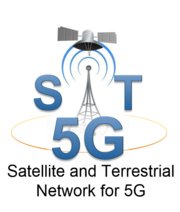|
|
| Line 98: |
Line 98: |
|
| |
|
| {| | | {| |
| |[[File:Sonata.png|180px|link=http://sonata-nfv.eu]]
| | |[[File:SaT5G.png|180px|link=http://sat5g-project.eu]] |
| ||[[File:Space.png|20px]]
| | ||[[File:space.png|20px]] |
| |'''SONATA''' is an EU-funded project Horizon 2020 and part of the 5G-PPP initiative on Agile Service Development and Orchestration in '''5G''' Virtualized Networks" which targets both the flexible programmability of software networks and the optimization of their deployments.
| |
| | |
| | |
| '''SONATA''' contributed a VIM emulator (vim-emu) to '''OSM Rel THREE'''. The '''vim-emu''', now part of '''OSM DevOps''', allows network service developers to locally prototype and test their network services in realistic end-to-end multi-PoP scenarios. It allows the execution of real network functions, packaged as Docker containers, in emulated network topologies running locally on the developer's machine. The emulation platform offers OpenStack-like APIs for each emulated PoP so that it can be easily integrated with MANO tacks. '''[https://osm.etsi.org/wikipub/index.php/VIM_emulator Learn more ...]'''
| |
| |}
| |
| | |
| | |
| ---------
| |
| ---------
| |
| | |
| {|
| |
| |[[File:SaT5G.png|180px|link=http://sat5g-project.eu/]] | |
| ||[[File:SaT5G.png|20px]] | |
| |'''SaT5G''' is a 5GPPP Phase2 project. SaT5G aims to foster the development of attractive “plug and play” SatCom solution for '''5G''', for telcos and network vendors to accelerate 5G deployment and at the same time creating new and growing market opportunities for SatCom vendors. This requires addressing three major challenges: | | |'''SaT5G''' is a 5GPPP Phase2 project. SaT5G aims to foster the development of attractive “plug and play” SatCom solution for '''5G''', for telcos and network vendors to accelerate 5G deployment and at the same time creating new and growing market opportunities for SatCom vendors. This requires addressing three major challenges: |
| # Exploit or mitigate SatCom capabilities (e.g. broadcast) or constraints (e.g. latency) in stand-alone or multi-link network topologies, | | # Exploit or mitigate SatCom capabilities (e.g. broadcast) or constraints (e.g. latency) in stand-alone or multi-link network topologies, |
| Line 121: |
Line 108: |
| * Ensure the orchestrator supports standards based creation of satellite VNFs and SDN in tandem with their terrestrial equivalents to create end-to-end network slices. | | * Ensure the orchestrator supports standards based creation of satellite VNFs and SDN in tandem with their terrestrial equivalents to create end-to-end network slices. |
| * Develop Northbound interface for the integrated network management and orchestrator to enable interworking with BSS/OSS. | | * Develop Northbound interface for the integrated network management and orchestrator to enable interworking with BSS/OSS. |
| | |} |
| | |
| | --------- |
| | --------- |
| | |
| | |
| | {| |
| | |[[File:Sonata.png|180px|link=http://sonata-nfv.eu]] |
| | ||[[File:Space.png|20px]] |
| | |'''SONATA''' is an EU-funded project Horizon 2020 and part of the 5G-PPP initiative on Agile Service Development and Orchestration in '''5G''' Virtualized Networks" which targets both the flexible programmability of software networks and the optimization of their deployments. |
| | |
| | |
| | '''SONATA''' contributed a VIM emulator (vim-emu) to '''OSM Rel THREE'''. The '''vim-emu''', now part of '''OSM DevOps''', allows network service developers to locally prototype and test their network services in realistic end-to-end multi-PoP scenarios. It allows the execution of real network functions, packaged as Docker containers, in emulated network topologies running locally on the developer's machine. The emulation platform offers OpenStack-like APIs for each emulated PoP so that it can be easily integrated with MANO tacks. '''[https://osm.etsi.org/wikipub/index.php/VIM_emulator Learn more ...]''' |
| |} | | |} |
|
| |
|



This page provides a list of Research activities that are using or contributing to OSM. Click on the logos for additional details.

|

|
5GCity is a 5GPPP Phase2 project, which is defining and building a platform that allows a city’s ICT infrastructure to be used for neutral hosting in a distributed and multi-tenant Cloud-to-Edge environment. This platform uses orchestration and service programming to integrate 5G services administered by a neutral host. These 5G services will be used by municipalities to host Smart City services, by Virtual Network Operators (VNO) to extend their networks, and by additional third party providers such as media or automotive verticals to offer innovative services to their customers.
5GCity plans to contribute and extend OSM in several directions:
- A Slice Manager functionality in line with 5GCity slice Information Models.
- An Infrastructure Abstraction component able to connect OSM to Edge and Extended Edge VIMs.
- Appropriate usage of the OSM NBI to connect "neutral hosting"-oriented Dashboard and SDK to the orchestration platform.
- Integration of OSM with MEC by using a thin layer on top of the two orchestrators (NFVO and MEC-O), pre-processing and dispatching the Services to one of the two according to appropriate descriptor extensions.
|

|

|
5Gtango is a 5GPPP Phase2 Innovation Action that enables the flexible programmability of 5G networks with:
a) an NFV-enabled Service Development Kit (SDK);
b) a Store platform with advanced validation and verification mechanisms for VNFs/Network Services qualification (including 3rd party contributions); and,
c) a modular Service Platform with an innovative orchestrator in order to bridge the gap between business needs and network operational management systems.
5Gtango is contributing to OSM Rel FIVE with:
- the support of novel packaging formats that are aligned with ETSI NFV SOL004.
- the development of an Slice Manager that will allow the deployment of 5G Network Slices with OSM.
|

|

|
5G-VINNI is a 5GPPP Phase 3 project, started in July 2018. The project is committed to leverage the latest 5G technologies, including results from previous 5GPPP phases, employing advanced network virtualization, slicing, radio and core technologies. In addition a rigorous automated testing campaign will be employed to validate 5G under various combinations of technologies and network loads.
5G-VINNI will be run at four main sites located in Norway, UK, Spain and Greece. In addition, experimental sites will be established in Germany and Portugal. Open APIs will be provided in order to ensure easy access to the 5G-VINNI facility. OSM is one of the NFV orchestration engines of choice.
5G-VINNI plans to contribute to OSM in several ways:
- With direct applicability experience in the deployment of 5G end-to-end services
- With the feedback from vertical users in realistic 5G and slicing scenarios
- With results of the integration of automated testing into the OSM stack
|

|

|
The overall Metro-Haul objective is to architect and design cost-effective, energy-efficient, agile and programmable metro networks that are scalable for 5G access and future requirements, encompassing the design of all-optical metro nodes (including full compute and storage capabilities), which interface effectively with both 5G access and multi-Tbit/s elastic core networks.
Metro-Haul project is contributing to OSM Rel FIVE a WAN Infrastructure Manager (WIM) plugin model that will enable the integration of different WAN control API technologies in the dynamic establishment of multi-site network services across WAN networks.
|

|

|
SaT5G is a 5GPPP Phase2 project. SaT5G aims to foster the development of attractive “plug and play” SatCom solution for 5G, for telcos and network vendors to accelerate 5G deployment and at the same time creating new and growing market opportunities for SatCom vendors. This requires addressing three major challenges:
- Exploit or mitigate SatCom capabilities (e.g. broadcast) or constraints (e.g. latency) in stand-alone or multi-link network topologies,
- Design SatCom solutions implementing 5G features (through virtualisation and/or adoptions of radio protocols),
- Ensure seamless integration of SatCom in 5G at network management and security levels.
SaT5G uses OSM for the following cases:
- Specify and implement ETSI-compliant VNFDs and NSDs adapting SatCom components.
- Ensure the orchestrator supports standards based creation of satellite VNFs and SDN in tandem with their terrestrial equivalents to create end-to-end network slices.
- Develop Northbound interface for the integrated network management and orchestrator to enable interworking with BSS/OSS.
|

|

|
SONATA is an EU-funded project Horizon 2020 and part of the 5G-PPP initiative on Agile Service Development and Orchestration in 5G Virtualized Networks" which targets both the flexible programmability of software networks and the optimization of their deployments.
SONATA contributed a VIM emulator (vim-emu) to OSM Rel THREE. The vim-emu, now part of OSM DevOps, allows network service developers to locally prototype and test their network services in realistic end-to-end multi-PoP scenarios. It allows the execution of real network functions, packaged as Docker containers, in emulated network topologies running locally on the developer's machine. The emulation platform offers OpenStack-like APIs for each emulated PoP so that it can be easily integrated with MANO tacks. Learn more ...
|

|

|
In Physics, superfluidity is a state in which matter behaves like a fluid with zero viscosity. The SUPERFLUIDITY project was a 5GPPP Phase 1 research project aimed at achieving superfluidity in networks: the ability to instantiate services on-the-fly, run them anywhere in the network (core, aggregation, edge) and shift them transparently to different locations.
The project demonstrated a converged cloud-based 5G concept addressing three forms of heterogeneity: heterogeneous traffic and sources; heterogeneous services and needs; and heterogeneous access technologies, with multi-vendor network components.
SUPERFLUIDITY contributed a new GUI to OSM Rel FOUR leveraging the new NBI based on ETSI NFV SOL005.
|
Would you like to see your research project / activity listed here? Please send an email to OSMSupport@etsi.org with the following information:
Subject: OSM Ecosystem - Research
- Project/Organisation name:
- Logo:
- URL:
- Short description:







